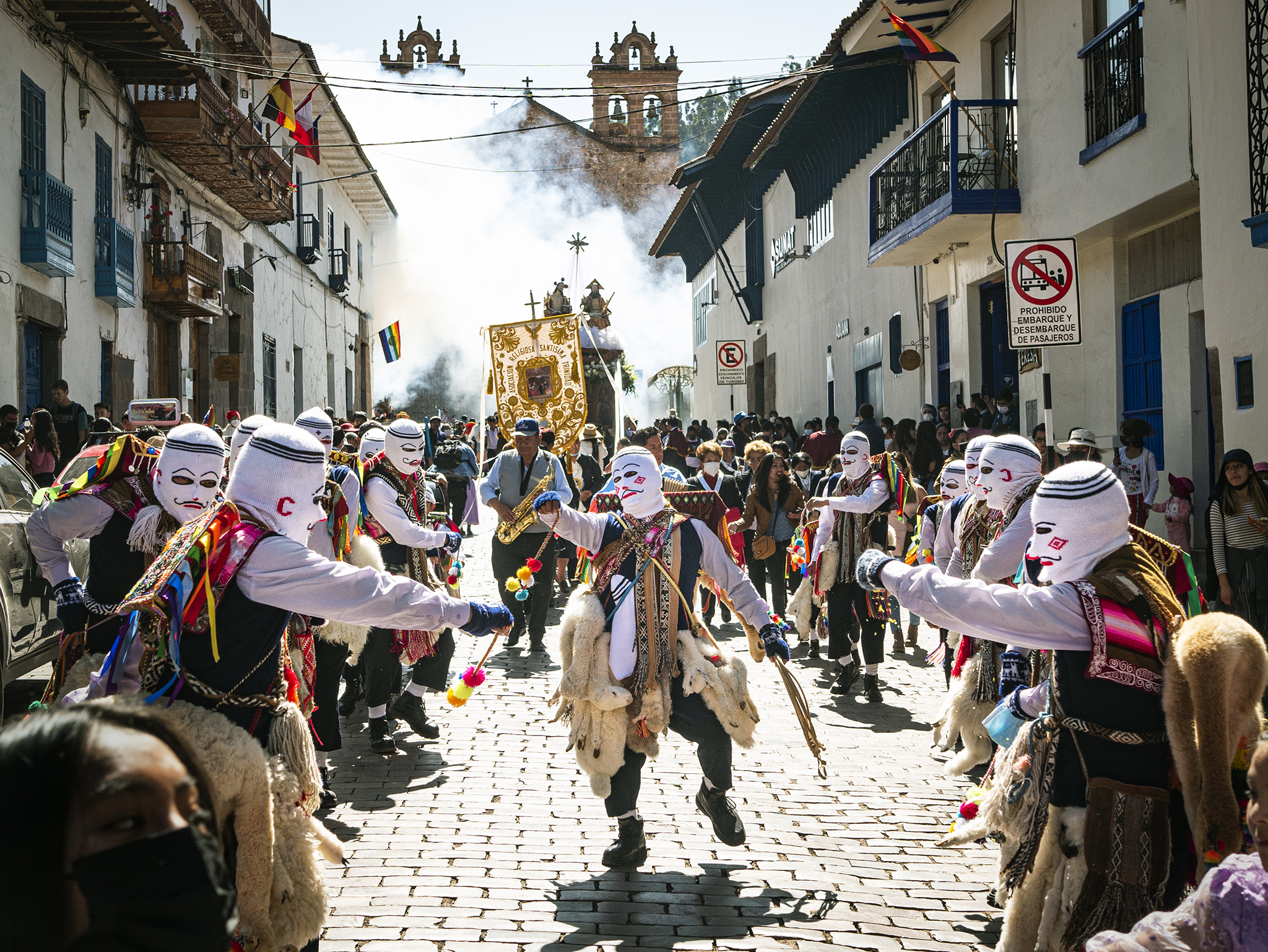The month of June in Cusco is pretty much one giant party in Peru’s cultural capital, with huge celebrations and parades occurring almost daily in the lead-up to Inti Raymi on June 24th – Cusco’s biggest day of the year.
I was lucky enough to spend almost all of June in Cusco and witness a wide range of the festivities, culminating with Inti Raymi, and in this post I’ll be taking a deep dive into the stories and characters behind the celebrations.
As we’ve mentioned in other posts, Peru has a long and complex relationship with religion, colonialism and its Indigenous people. Upon the arrival of the Spanish conquistadors in 1528, a war was waged against the Inca Empire. It’s estimated that by the time the conquest was completed in 1572, three quarters of the Indigenous population had been killed by a combination of conflict and disease. Many of the traditional customs and practices of the Inca were lost as a result, but many also survived, and over time these traditions have merged with the beliefs of the Catholic colonisers.
Initially, this was a form of preservation. The practicing of Indigenous beliefs was outlawed by the invaders in an attempt to force assimilation upon the remaining Inca, so incorporating Inca practices into a Catholic framework allowed people to maintain some level of attachment to their culture.
However, as time went on, and the lines between Spanish and Indigenous became increasingly blurred, Peru slowly arrived at the unique blend of Catholic and Inca culture that defines its religiosity today. At the centre of this culture are the extravagant celebrations of religious holidays, both Catholic and Inca, and the myriad of interesting characters that take part in them.

To kick things off, these crazy balaclava-clad guys are Qhapaq Qollas (pronounced ka-pak coy-yas), and before you ask – yes, those are dead baby llamas that they’re wearing around their waists. We’ll get to that…
In Quechua, the most prominent Indigenous language in Peru, the word Qhapaq means noble or mighty, while Qolla is the name of the Indigenous people being honoured by the dancers. Each of the characters in this post represents either a mythical being from Inca folklore, or an important figure from Peru’s colonial history – or in some cases, both.
The Qhapaq Qollas are representations of a fabled creature who was half human, half llama, but they also symbolise the old merchants from the Altiplano region surrounding Lake Titicaca in Peru’s south. During the centuries that followed the Spanish conquest of the Inca, these merchants would travel more than a thousand kilometres from the city of Potosí to the south, all the way to Cusco in the north, in order to trade various goods – such as the wool of llamas and vicuñas.
The performance of the Qhapaq Qollas involves two rows of individuals that dance around a central figure who represents a llama herder. The rows move in and out while swinging around colourful balls attached to the end of a rope, and the image at the top of this post gives a good visual representation of the chaotic hoedown.
However, despite their cultural significance, I had my concerns about the ethics surrounding the Qhapaq Qollas’ costume designs…


Undoubtedly the most striking aspect of the Qhapaq Qollas’ performance is seeing dozens of dead baby llamas swinging from dancers’ waists as they boogie to the beats of a brass band.
Given the Inca’s predilection for animal sacrifices, I wondered whether the young llamas had suffered such a fate in order for the festivities to take place. However, I was assured by multiple people that they had all died from natural causes.
“In the winter, some of the baby llamas die from the cold,” one of the Qhapaq Qollas told me. “After they die, they use these animals. It’s not a sacrifice.”
The sceptic in me still feels like it was a rather large number of baby llamas to have died naturally. But given that they seemed to be well-preserved, it’s possible that the llamas were being reused in subsequent years, and I’m willing to give the Qhapaq Qollas the benefit of the doubt. (I mean, its not like I was going to go around lecturing a bunch of balaclava-clad men about animal ethics in a foreign country anyway.)





Next up in our perusal of Peruvian protagonists are the Qhapaq Ch’unchus – the noble people of the jungle. These dancers represent the Indigenous communities of the Amazon region, and wear ornate clothes, with an extravagant feather hat and a staff that symbolises a hunting spear. They are accompanied by the Rey Ch’unchu – the Ch’unchu King – who leads the dance and is adorned by a gold crown with red feathers, and a dramatic crimson cape.
The feathers used in the elaborate headwear are from the Suri – the largest bird in the Americas. These huge, flightless birds are distant relatives of the ostrich and the emu, and their feathers are often used as dusters in homes across South America (so I guess the Qhapaq Ch’unchus would probably make good chimney-sweepers in the off season).
The dance of the Qhapaq Ch’unchus is a particularly vibrant and enthusiastic one. The participants are constantly bounding and weaving in between each other, with more jumping than a Riverdance audition. The performance appears to have been deliberately designed to make the feathers of their magnificent hats bounce in a continually hypnotic fashion, like the appendages of some exotic sea creature.
Mock battles are interspersed in the routine, with the rows of dancers separating and then coming together to clash their spears against one another – all to the beat of the accompanying drums and pan flutes.
In the last image of the Qhapaq Chu’unchus above, you’ll notice a sneaky figure on the right hand side who doesn’t seem to fit the mould of the other dancers. This is a Maqt’a, the jovial jokester who was my favourite of Cusco’s dancers.





Easily the most entertaining of Cusco’s dedicated dancers, Maqt’as are exaggerated caricatures of the campesinos – Peruvian agriculturalists – and their role is to maintain public order during the celebrations. However, they’re not the most reliable workers, and are typically found enflaming chaos rather than preventing it.
Unlike all the other participants in the festivities, the Maqt’a is not subject to any authority, and roams the streets of Cusco as a lone wolf. His costume is vibrantly colourful, with a goofy mask and a wool whip.
Why the whip? Well, stray too far into the middle of the road as a troupe of dancers are approaching, and you’ll be sure to find out.
The Maqt’a whips members of the public out of the way of the procession, and plays harmless jokes on unsuspecting tourists. Occasionally, he’ll even burst into sudden and dramatic monologues about current affairs – a kind of Peruvian street edition of Stephen Colbert.
The Maqt’as are sometimes accompanied by Saqras, mischievous demon characters from Inca folklore who wear elaborate costumes that remind me of the Lucha Libre wrestlers of Mexico – with added horns and a devilish mask. The Saqras are said to be trapped in limbo, and play yet more tricks on the audience in an attempt to escape their purgatory.


In the more rural, traditional performances, found in places like Paucartambo, the Maqt’as are known to spray audiences with beer, and playfully attack wrongdoers with taxidermied animals. Cusco, on the other hand, appears to have a slightly more sanitised version of events, so as not to offend the naïve tourists.
The Maqt’as are by far the most energetic dancers on Cusco’s streets. Their moves are lawless and ecstatic, as if dominated by some external force. I trailed one Maqt’a for around an hour or so as he moved with the parade, and every so often a member of the crowd would give him something to drink, like an exhausted marathon runner. Each time this occurred, he’d remove his mask to reveal a face utterly drenched in sweat, before guzzling the entire bottle of whatever he’d been handed.
Before he could catch his breath, however, the mask would return, and the Maqt’a would dart back into the fray once more.




Perhaps the most captivating figures on Cusco’s streets are the Qhapaq Negros – the ‘Noble Blacks’. These nuanced characters are representative of the black slaves who were brought to Latin America during the colonial era. Originally forced to work in Potosí, large numbers were transferred to the gold and silver mines of Paucartambo, near Cusco, where they wrote themselves into the region’s history and folklore.
The Qhapaq Negros are dressed in vivid colours, yet they carry chains to signify their exploitation and maltreatment. Their masks are designed to dramatically convey the emotional journey of the slaves themselves – from fear and anger at their unjust oppression, to joy and pride at their emancipation and enduring culture.


The Qhapaq Negros are led by the vibrantly-clothed Caporal, the Black King, who directs his dancers and musicians using a matraca – a kind of wooden rattle. He is accompanied at the front of the troupe by a child – in this case an adorable kid who I reckon was only around five or six years old, but knew all the moves and danced passionately throughout the entire day.
This is unsurprising, given that the Qhapaq Negros are regarded as some of the most devoted dancers in all of the festivities. Many of the other dancers are exaggerated caricatures of historical figures, often with a comedic pretence layered over the top. The Qhapaq Negros, however, display a deeper level of respect for those they are portraying, and appear starkly aware of the suffering and trauma that accompanies their story.

The month of June in Cusco is one of the world’s most vivid and joyful cultural spectacles. The Qhapaq Qollas, Ch’unchus, and Negros, alongside the Maqt’as and Saqras, represent a magnificent myriad of dancers – each with their own unique historical significance behind them.
As we mentioned at the beginning of this post though, all of the festivities in June lead up to the biggest celebration of the year on June 24th.
We thought Inti Raymi deserved a whole post of its own though, so be sure to check it out here.


